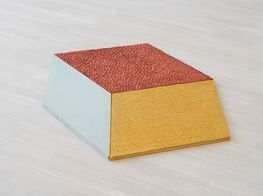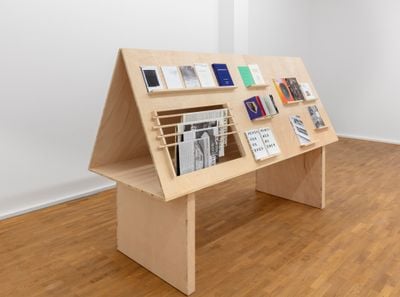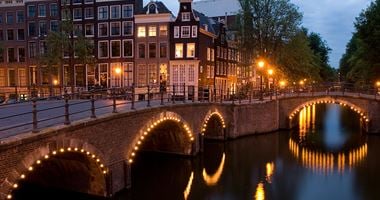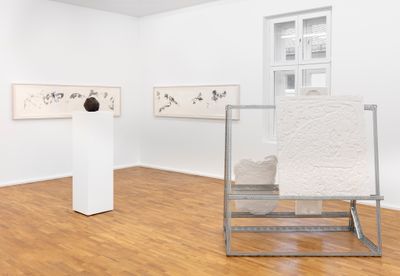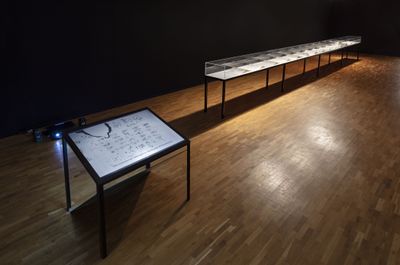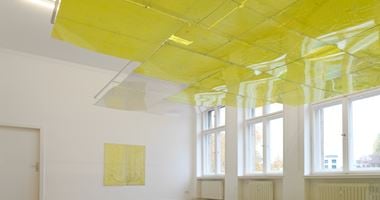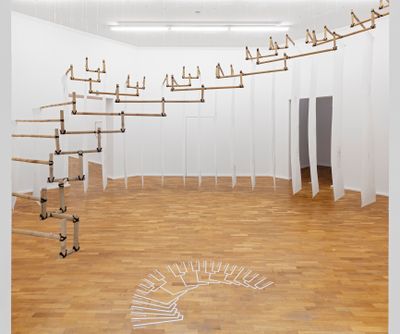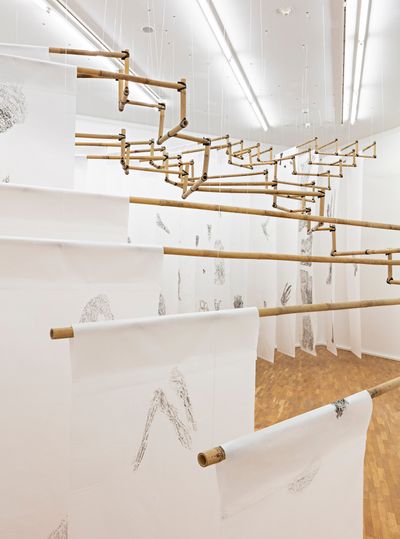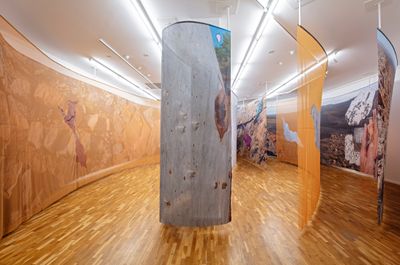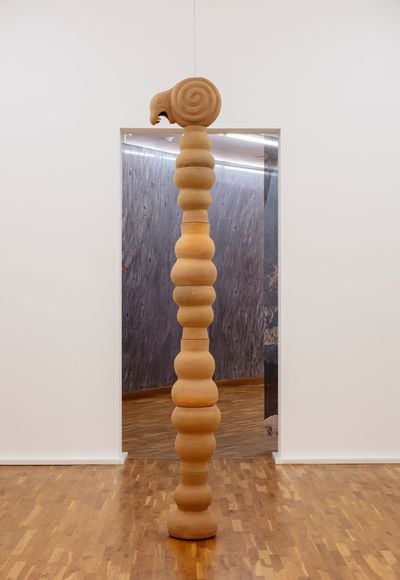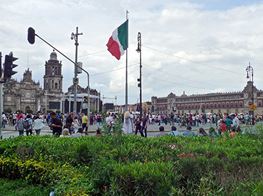Mariana Castillo Deball's Archaeology of Time
Mariana Castillo Deball started thinking about archaeology when renovations to her mother's garden were stopped because a worker dreamed of something valuable buried there. That 'feeling that there is always something underneath', says Deball, connects to the (impossible) 'fantasy that we can actually connect to our past.'1
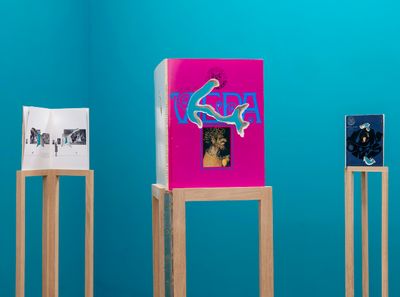
Mariana Castillo Deball, Do Ut Des (2009–2019). Exhibition view: Amarantus, MGKSiegen, Siegen (29 January–30 May 2021). Courtesy the artist. Photo: Philipp Ottendörfer.
Deball first integrated archaeology into her project These Ruins You See (2006–2007), comprising an empty museographical environment, archive of documentary images, audio guide, and a publication shown at Mexico City's Museo de Arte Carrillo Gil, for which she excavated 'the warehouses, attics, and basements in which museums house their outmoded didactic materials, obsolete replicas, crates, cases, dusty models, broken casts, and dirty secrets.'2
Drawn to 'the margins of archaeology', Deball's focus was not on archaeological practice itself, but on the networks and agents constellating it, including its connection to education, particularly in Mexico, where, quoting Jesse Lerner, 'the archaeological record has a way of regularly insinuating its way into everyday life.'3
Working with anthropologists and archaeologists, Deball developed a 'repertoire of themes and ways of working'4 that invokes Surrealist writer Roger Caillois's concept of 'diagonal science', in which 'neglected correlations' are drawn out through radical trans-disciplinarity.5
Amarantus, the artist's current exhibition at MGKSiegen (29 January–30 May 2021) is the first to cover her entire oeuvre in Germany, spanning 15 years. Included are two projects from 2004 that mark a transition in Deball's practice, from working with printed matter—Deball is also a writer and editor—to an engagement with the exhibition space, in particular the context of the museum, as a mode of intervention rather than display.6
For Institute of Chance, created for the Prix de Rome (which Deball was awarded in 2004), Deball sent unidentified photos from the archive of the International Institute for Social History to people in Amsterdam with a narrative communicated by a fictional anarchist, while The wall and the books: 987 words stolen from a library (2004), consists of 987 words 'stolen' from books in the Jan van Eyck Academie library in Maastricht to form the titular short story by Jorge Luis Borges.
Modes of reconstitution and reinvention come through, too, in You have time to show yourself before other eyes (2014), first shown at the Berlin Biennale in 2014, which displays plaster replicas of objects from the Mesoamerican collection at the Ethnological Museum in Dahlem, made with the Gipsformerei (Replica Workshop) in Berlin.
These plaster copies draw on the artist's research into 19th-century English archaeologist Alfred Maudslay, whom Deball learned about while working on her 2013 exhibition at Chisenhale Gallery in London. Maudslay devised a papier-mâché technique to make paper moulds, which rendered elements from Mayan sites across Mexico and Guatemala—some of which were destroyed or disappeared during World War II—into plaster casts.
As Deball points out, replicas often hold more information than the originals.7 The textures of her own casts, for instance, reveal not only the object's surface, but the grains of paper used—marks constituting an ever-expanding cartography that Deball's interventions stretch further.8
Drawn to 'the margins of archaeology', Deball's focus was not on archaeological practice itself, but on the networks and agents constellating it...
'An object actually doesn't exist if there is not a relationship that activates it', the artist has said. 'In that sense, what is really amazing about archaeology is that you have an object that can actually have so many lives, so many ways of existing, of becoming present.'9
These many lives unfold in El dónde estoy va desapareciendo (The 'Where I am' is disappearing) (2011), a ten-metre leporello of ink drawings on cotton paper and a 20-minute video produced for the 2011 Venice Biennale in cooperation with Barbara Wien gallery, and now part of MGKSiegen's collection.
The video tracks the journey of the Borgia Codex, a pre-Columbian Mesoamerican codex that survived the Spanish book burnings and was taken to Europe by Cardinal Borgia and ended up in the Vatican library in Rome. It was left unread for centuries until a Mexican Jesuit, Alexander von Humboldt and other scholars began to decipher its mysteries. The codex's story is told in the languages of its different owners—Nahuatl, Spanish, Italian, German, and English.
Deball's object activations create another frame for those she has brought into her Siegen show. Among them is the Silver Baptismal Bowl of Siegen, which will inform an artwork that Deball will introduce into the exhibition at a later stage, whose journey has been described as being 'among the most outlandish and fantastic . . . in South American silverwork.'10
Made in Peru in the late 16th century, a Congolese king apparently gifted the bowl to the 17th-century Prince Johann Moritz of Nassau-Siegen during his time as the governor of the Dutch West India Company in Brazil, who then gifted it to the local Nikolaikirche in Siegen.11
Other works chart longer trajectories, pulling back layers towards deep time. The spiral-shaped bamboo installation Pleasures of Association, and Poissons, such as Love– (2017) covers a period of 200 million years through ink rubbings of different vertebrates from the Museum of Natural History in Berlin, while Once I thought the world was somewhere else (2021) fills one room with layers of hanging textiles printed with images of Ediacaran fossils from South Australia.
Creating temporal encounters is at the heart of Deball's work, and collaboration constitutes a crucial mode of this lived relation. In the case of Mechanical Column (Serignan), Rhomboid (Serignan), and Snake (Serignan) (all 2015), totems echoing Brancusi's Endless Column comprise ceramics by Atzompa potters, known for a style of glazed pottery, connecting to the archaeological heritage of their native Oaxaca.
First exhibited at Museo de arte contemporáneo de Oaxaca (Who will measure the space, who will tell me the time?, 24 January–20 March 2015), Deball worked with Kythzia Barrera from the institution Innovando la tradición and the Martínez Alarzón family from Atzompa to visualise the story of the universe through objects from the archaeological museum Rufino Tamayo, adding nuts and gears found in Ramiro Alarzón's workshop.
The forms of these columns seem to most explicitly relate to the title of Deball's MGKSiegen show, which refers to the common amaranth plant, whose seeds feature in Mexican diets and religious rituals, and was banned for a time during Spanish colonisation of the Americas.
As the curatorial text points out, the plant's name in Greek translates to 'a flower that never wilts'—a fact that frames the conception of time and its objects in Deball's work as both organically static and enduring.—[O]
1 Conversations | Artistic Practice | The Artist as Archaeologist', Art Basel, YouTube, 20 June 2015, https://www.youtube.com/watch?v=a5zB4lmb7B4.
2 Adam T Sellen, 'The Consul of Deception. The Greatest Archaeological Faker of the Twentieth Century', Sternberg Press (2008): p. 161.
3 'Conversations | Artistic Practice | The Artist as Archaeologist', Art Basel, YouTube, 20 June 2015, https://www.youtube.com/watch?v=a5zB4lmb7B4.
4 Ibid.
5 Mariana Castillo Deball: Finding Oneself Outside, New Museum, New York (22 January–5 May 2019), exhibition press release: https://www.newmuseum.org/exhibitions/view/mariana-castillo-deball.
6 'Mariana Castillo Deball: Amarantus: Artist talk with director Thomas Thiel', MKSiegen, YouTube, 31 January 2021), https://www.youtube.com/watch?v=LsKA-TI1WTk.
7 'Conversations | Artistic Practice | The Artist as Archaeologist', Art Basel, YouTube, 20 June 2015, https://www.youtube.com/watch?v=a5zB4lmb7B4.
8 'Mariana Castillo Deball: Amarantus: Artist talk with director Thomas Thiel', MKSiegen, YouTube, 31 January 2021), https://www.youtube.com/watch?v=LsKA-TI1WTk.
9 'Conversations | Artistic Practice | The Artist as Archaeologist', Art Basel, YouTube, 20 June 2015, https://www.youtube.com/watch?v=a5zB4lmb7B4.
[10] Elena Phipps, Johanna Hecht, Cristina Esteras Martín, and Cristina Esteras Martin, The Colonial Andes: Tapestries and Silverwork, 1530–1830, (The Metropolitan Museum of Art, New York, 2004), p. 211.
[11] Ibid.

